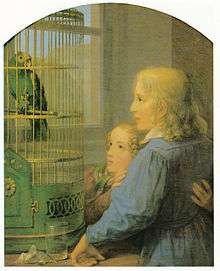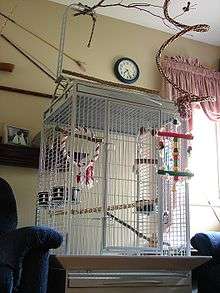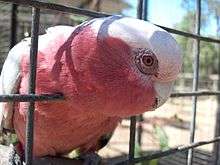Birdcage


A birdcage (or bird cage) is a cage designed to house birds as pets.
Antique (or antique-style) birdcages are often popular as collectors' items or as household decor but most are not suitable for housing live birds, being too small, or of unsafe materials or construction. Good quality cages designed for pet birds are more suitable.
Most parrot cages are made or wrought iron and painted with a non-toxic paint referred to as powder-coating. However, the newest trend in the market is cages made of solid stainless steel. Large parrot cages made of stainless steel can cost thousands of dollars and will actually outlive a powder-coated cage by 5 to 6 times. While small cages are relatively cheap, large parrot-sized cages can cost hundreds or even thousands of dollars. The materials used to build the cages has a lot to do with the price level.
Size and requirement
In general, the larger and the more active the bird, the larger the cage one should use. The amount of time the bird will spend in the cage each day is also a factor. A bird that is caged most of the time requires far more space than a bird caged only at night.
Some birds have special requirements. Amazons and cockatiels prefer horizontal bars, as they like to climb. Messy eaters should have a seed skirt to catch food. Breeding birds may require a nest or breeding box and a larger size cage. Smart birds, like parrots and crows, need secure latching mechanisms to prevent them from figuring them out, and often require toys and/or playstands to keep them entertained. Parrots in general tend to gnaw on cages, with larger macaws known to tear bars from flimsy cages. Zinc coated cages or chicken wire could cause toxicity to parrots over a number of years.

Safety
A cage for a tame pet bird which is allowed out daily should be large enough to allow it to easily extend its wings fully without hitting cage sides or toys or objects within the cage. In some countries, it is illegal to house a pet bird in a cage that does not permit it to spread its wings. Wingspans of common pet birds range from approximately 30 cm (12 in) for a budgie and 41 cm (16 in) for a cockatiel up to as much as 91–122 cm (36–48 in) for the larger macaws.
Untame birds which are not allowed out of their cages regularly, such as most finches and canaries, require larger cages that are long enough to permit some flight. The bars should be spaced so that curious birds cannot stick their heads out of the cage and become stuck. The cage should also have non-toxic paint, because birds tend to gnaw at the cage, and if the paint is consumed, they can die from poisoning.
Cages should also be equipped with appropriate perches. There should be several diameters of perches available, but the diameter should be large enough so that the bird's toes are unable to overlap or completely wrap around the perch. Flight cages and aviaries should be equipped with perches at each end with open space in the middle for flight.
See also
External links
![]() Media related to Bird cages at Wikimedia Commons
Media related to Bird cages at Wikimedia Commons